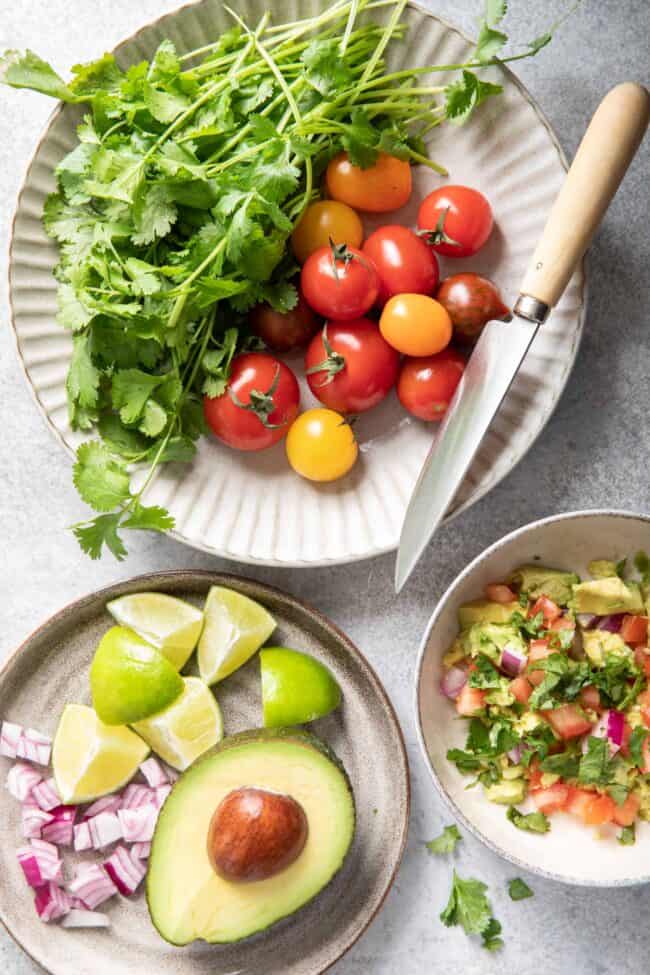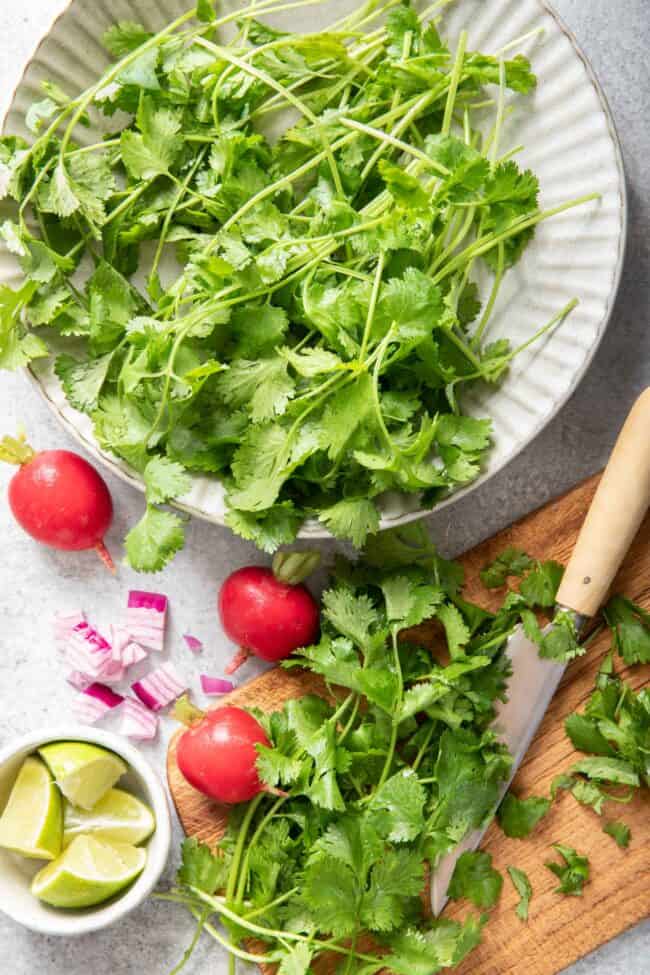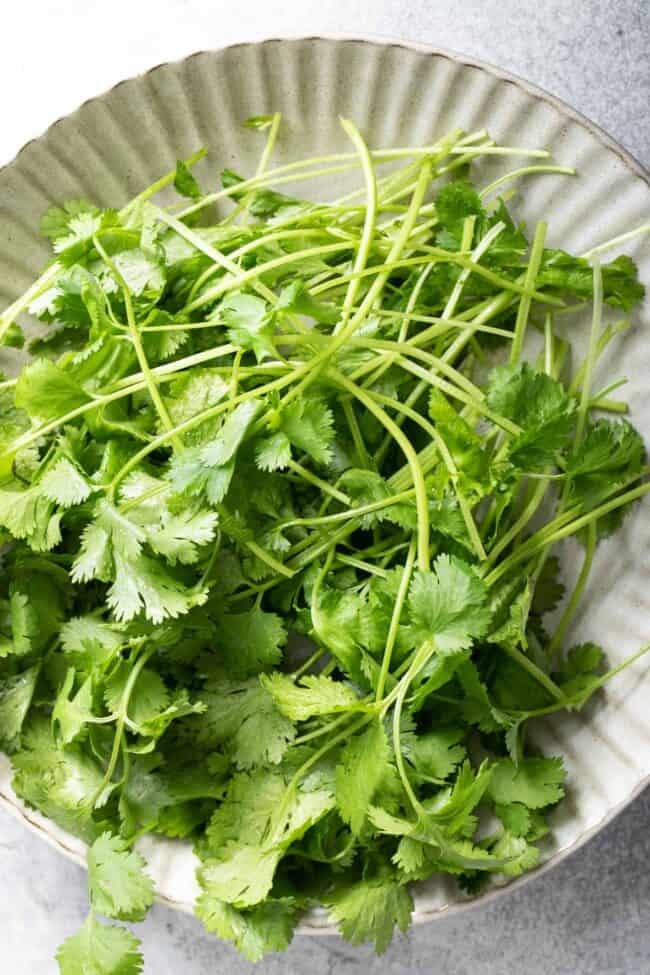Cilantro Substitute
Need a good substitute for cilantro? Fresh cilantro has a unique flavor that’s hard to replace. But if you’re in a pinch and need a replacement, here’s the top three best fresh cilantro substitutes you can use.
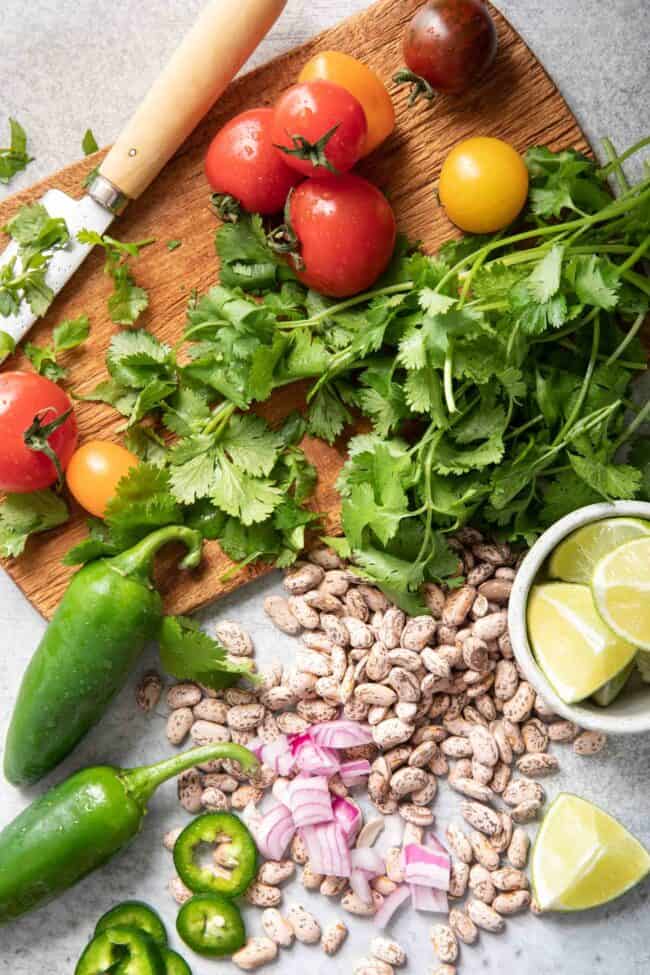
If you’re making a recipe that calls for cilantro and you don’t have any on hand, there’s a few substitutes you can use to replace it, though the flavor won’t be quite the same.
Fresh cilantro has a unique bright citrusy flavor that’s hard to match, but you can substitute it with several different herbs (like parsley, basil, celery leaves, and a few less common herbs like Culantro and Papalo), or simply add a squeeze of lemon or lime juice to your dish to replace the citrusy flavor of cilantro.
What Is Cilantro?
Cilantro (Coriandrum sativum) is a fragrant herb that is slightly peppery with a bright citrus flavor. This herb is from the Apiaceae family, and the seeds from this plant are known as coriander. Fresh cilantro is an important ingredient used in many Mexican, South American, Asian, Thai and American cuisines.
How Do You Use Fresh Cilantro?
Cilantro is commonly used to add a unique fresh pop of flavor to many dishes like salads, soups and stews, and it’s a featured ingredient used in salsas, sauces and dressings.
What Does Cilantro Taste Like?
Cilantro is slightly peppery with a bright citrusy flavor.
Fresh Cilantro vs Dried
Fresh cilantro has a fragrant scent and a bright citrus and mild peppery flavor. Dried cilantro doesn’t have much flavor at all, and for this reason, it’s not an ideal substitute for fresh cilantro.
Best Cilantro Substitutes
1. Parsley
Flat-leaf parsley leaves (also called Italian parsley) look a lot like cilantro and the two herbs comes from the same botanical family. Curly parsley has a mild flavor and is used mostly used as a garnish rather than to cook with. Flat-leaf parsley similar flavor to cilantro, although it’s a little more bitter tasting and doesn’t have the same citrusy flavor as cilantro. Flat-leaf parsley is the best ingredient to use as a fresh cilantro substitute. Add a squeeze of fresh lemon juice to it before adding it to your dish to get that perky citrusy flavor of cilantro. Use parsley in a 1:1 ratio for fresh cilantro.
2. Basil
Basil is a common herb featured in Italian and Asian cuisine. It has a sweet and slightly peppery flavor. It can be used as a substitute for cilantro in certain dishes like sauces and curries. Use fresh basil in a 1:1 ratio for fresh cilantro.
3. Celery Leaves
Celery leaves have a mild flavor that can be used as a substitute for cilantro in soups, stews, salads or as a garnish. Use fresh celery leaves in a 1:1 ratio for fresh cilantro.
What Parts of Cilantro Do You Use?
Cilantro leaves and stems are edible. Cilantro leaves are most commonly used as a garnish. These delicate leaves tend to lose most of their flavor when cooked, so they’re best used to sprinkle over your dish after it’s been cooked. The stems are a little more potent and durable than the leaves, so they’re are good to cook with.
Should You Rinse Cilantro Before Using It?
Yes, you should rinse cilantro before adding it to a dish.
Fill a bowl with cold water and swish the leaves around with your fingers. Dirt and debris will fall to the bottom of the bowl. Then put the sprigs in a salad spinner to dry or gently pat them dry using paper towels. Discard wilted, slimy or yellow leaves.
How Do You Chop Cilantro?
What’s The Best Way To Store Cilantro?
It’s best to store fresh cilantro in the refrigerator with the stems still attached. Place the stems in a glass of water and loosely cover the leaves with a plastic bag. If the stems have been cut away, then wrap the leaves in a damp paper towel and place them in a plastic bag leaving the end open for circulation. Cilantro with stems attached can last up to 1 week and without the stems it’ll last between 3 to 5 days.
Is Cilantro Good For You?
Cilantro contains antioxidant and anti-inflammatory properties, including flavonoids like quercetin and kaempferol which may help to ward off certain diseases.
How Many Calories In Cilantro?
Two tablespoons of fresh cilantro is about 1 calorie.
How Do You Cook With Cilantro?
Cilantro adds fresh lemony flavors to many dishes, but it tends to lose its flavor when cooked for a long period of time. Adding it at the end of cooking or sprinkling it on top of your dish after it has already been cooked will add the most flavor to your dish.
8 Ways To Use Fresh Cilantro
- Dips and Sauces: Add it to dips and sauces like Pico de Gallo, Mango Salsa, Jalapeno Hummus, Salsa Verde, Chimichurri Sauce, Restaurant Style Salsa and Guacamole
- Salads: Sprinkle it in salads for a fresh pop of flavor like this Asian Cucumber Salad, Mexican Watermelon Salad, Southwest Quinoa Salad, Mexican Bean Salad, Quinoa Black Bean Salad, Avocado Egg Salad, Mango Arugula Quinoa Salad, Mango Slaw and Mexican Fruit Salad.
- Salad Dressings: It adds a lot of flavor when added to salad dressings like this Avocado Salad Dressing, Cleansing Lemon Herb Vinaigrette and Cilantro Lime Vinaigrette.
- Soup and Chili: Add it to soups (or simply garnish soups with it) like Mexican Chicken Rice Soup, Carrot Ginger Soup, Vegan Tortilla Soup, and Chicken Posole.
- Pesto:Use it to make a delicious Cilantro pesto like this Basil Pesto and Arugula Pesto.
- Garnish: It makes a great garnish for many dishes like this Tortilla Pizza, Chicken Fajita Casserole, Pineapple Coconut Quinoa, Creamy Black Beans, Chicken Fajita Stuffed Sweet Potatoes.
- Burgers: Take your burger game to the next level by adding cilantro, avocado and salsa to make burgers like these Mexican Chicken Avocado Burgers,
- Rice: Stir it into cooked rice like this Mexican Cauliflower Rice, Spanish Rice and Beans and Spanish Rice.
More Resources
- Bay Leaf Substitute
- Basil Substitute
- Rosemary Substitute
- Mint Substitute
- Tomato Sauce Substitute
- Tomato Paste Substitute
- How Much Juice in One Lime
- How Much Juice in One Lemon
- How to Zest a Lemon
- How to Freeze Spinach
- How to Freeze Tomatoes
- How to Cut a Pomegranate
- How to Store Tomatoes
- How to Poach Chicken
- How to Freeze Bananas for Smoothies
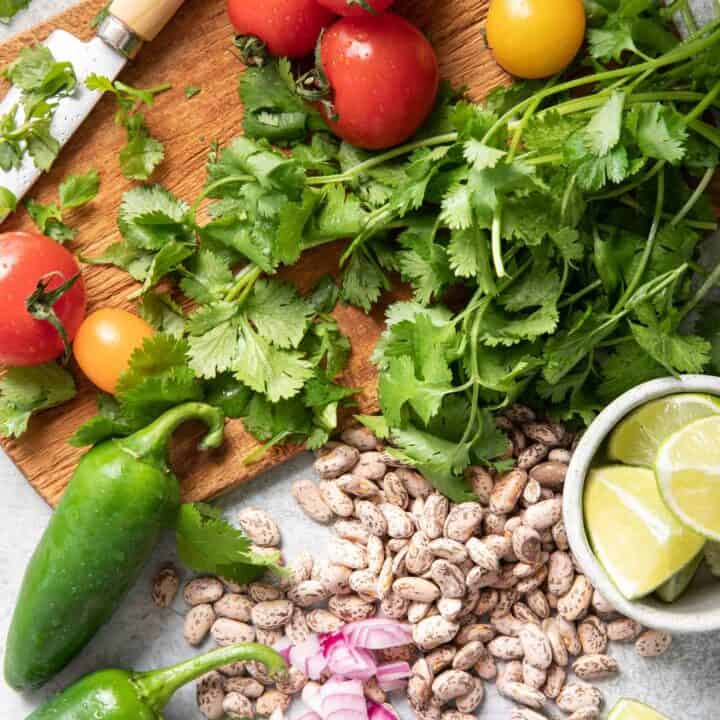
Cilantro Substitute
Need a good substitute for cilantro? Fresh cilantro has a unique flavor that's hard to replace. But if you're in a pinch and need a replacement, here's the top three best fresh cilantro substitutes you can use.
Ingredients
- 1 tablespoon fresh parsley
- 1 tablespoon fresh basil
- 1 tablespoon celery leaves
Instructions
- Flat-leaf parsley similar flavor to cilantro, although it's a little more bitter tasting and doesn't have the same citrusy flavor as cilantro. Flat-leaf parsley is the best ingredient to use as a fresh cilantro substitute. Add a squeeze of fresh lemon juice to it before adding it to your dish to get that perky citrusy flavor of cilantro. Use parsley in a 1:1 ratio for fresh cilantro.
- Basil is a common herb featured in Italian and Asian cuisine. It has a sweet and slightly peppery flavor. It can be used as a substitute for cilantro in certain dishes like sauces and curries. Use fresh basil in a 1:1 ratio for fresh cilantro.
- Celery leaves have a mild flavor that can be used as a substitute for cilantro in soups, stews, salads or as a garnish. Use fresh celery leaves in a 1:1 ratio for fresh cilantro.
Notes
What Parts of Cilantro Do You Use?
Cilantro leaves and stems are edible. Cilantro leaves are most commonly used as a garnish. These delicate leaves tend to lose most of their flavor when cooked, so they're best used to sprinkle over your dish after it's been cooked. The stems are a little more potent and durable than the leaves, so they're are good to cook with.
Should You Rinse Cilantro Before Using It?
Yes, you should rinse cilantro before adding it to a dish.
Fill a bowl with cold water and swish the leaves around with your fingers. Dirt and debris will fall to the bottom of the bowl. Then put the sprigs in a salad spinner to dry or gently pat them dry using paper towels. Discard wilted, slimy or yellow leaves.
How Do You Chop Cilantro?
To chop cilantro well the leaves need to be completely dry. Cilantro leaves are delicate and when they're wet they tend to clump together and stick to everything including the knife. Be sure to use a sharp knife that will chop well. Dull blades will mash and muddle the leaves making it difficult to sprinkle them as a garnish over a dish.
What's The Best Way To Store Cilantro?
It's best to store fresh cilantro in the refrigerator with the roots still attached. Place the roots in a glass of water and loosely cover the leaves with a plastic bag. If the roots have been cut away, then wrap the leaves in a damp paper towel and place them in a plastic bag leaving the end open for circulation. Cilantro with roots attached can last up to 1 week and without the roots it'll last between 3 to 5 days.
How Do You Cook With Cilantro?
Cilantro adds fresh lemony flavors to many dishes, but it tends to lose its flavor when cooked for a long period of time. Adding it at the end of cooking or sprinkling it on top of your dish after it has already been cooked will add the most flavor to your dish.
Nutrition Information:
Yield:
1Serving Size:
1Amount Per Serving: Calories: 3Total Fat: 0gSaturated Fat: 0gTrans Fat: 0gUnsaturated Fat: 0gCholesterol: 0mgSodium: 8mgCarbohydrates: 1gFiber: 0gSugar: 0gProtein: 0g
theharvestkitchen.com attempts to provide accurate information, however, this nutritional information is provided as a courtesy and is an estimate only. The nutritional information provided comes from online sources and calculations. See full disclaimer on About page.
